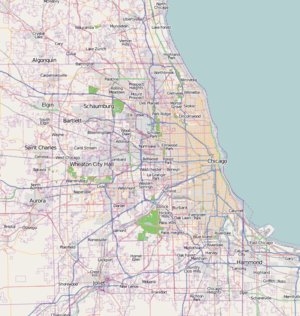Goldblatt's
| Industry | Retail |
|---|---|
| Fate | Liquidated |
| Founded | 1914 |
| Defunct | 2003 (final liquidation; all stores closed by 2000) |
| Headquarters | Chicago, Illinois, U.S. |
| Products | Clothing, footwear, bedding, furniture, jewelry, beauty products, electronics and housewares |
Goldblatt's was an American chain of local discount stores that operated in Chicago, Illinois as well as Indiana, Michigan and Wisconsin. Founded in 1914, the chain grew to more than twenty stores at its peak, gradually closing its stores in the 1990s and selling others to Ames before finally closing completely in 2000.
History
Early beginnings
|
Goldblatt Bros. Department Store | |
.jpg) | |
   | |
| Location | 4700 S. Ashland Ave., Chicago, Illinois |
|---|---|
| Coordinates | 41°48′30″N 87°39′55″W / 41.80833°N 87.66528°WCoordinates: 41°48′30″N 87°39′55″W / 41.80833°N 87.66528°W |
| Area | less than one acre |
| Built | 1915 |
| Architectural style | Chicago |
| NRHP Reference # | 06001016[1] |
| Added to NRHP | November 15, 2006 |
Goldblatt's was founded in 1914 by brothers Nate and Maurice Goldblatt. Immigrants from Poland, the Goldblatt family ran a grocery store and butcher shop on Chicago's West Side. Nate and Maurice opened their first store near the corner of Ashland and Chicago Avenue. By 1922, the store recorded sales of over $800,000.[2] By 1928 the brothers formed Goldblatt Brothers Inc. During the Great Depression of the 1930s Goldblatt's did well, and the brothers were able to purchase several smaller department stores.
In 1936, Goldblatt's opened their State Street flagship store at State and Van Buren. Goldblatt's moved towards more upscale products and offered small appliances, a deli, and confectionery goods.
Bankruptcy
By 1946 Goldblatt's was operating 15 stores with $62 million in annual sales. Things went well even as the Goldblatt brothers began to quarrel. In 1941, a one-store expansion into Buffalo, New York was met with little success; the store closed on November 27, 1948, following a unionization attempt by the employees.[3] By the 1950s growth began to stall, with profits flatlining and new store openings averaging four a year.
By the mid-1960s, retailers such as Kmart, Woolco, Zayre, and Sears were digging into Goldblatt’s market. Their expansion into the suburbs proved to be a difficult obstacle for Goldblatt's. Middle class shoppers were not enticed to shop at Goldblatt's. The company declared bankruptcy in 1981.
In 1982, Goldblatt's reopened with six stores. The mission of the company was restored to selling to low income families. Their flagship store, which was to be sold to City of Chicago under Mayor Jane Byrne for a public library location,[4] later sold to DePaul University when the Harold Washington Library was built. Without the money from the City of Chicago Goldblatt's would have closed. Jerrold Wexler helped save the firm from bankruptcy.[2] By 1985 Goldblatt's was profitable.
However, changing markets, increasing competition, and old stores doomed the chain. Around 2000, Goldblatt's closed for good. In 2003, the company liquidated.
Ames
Shortly after Goldblatt's closed its stores, discount retailer Ames purchased seven of the stores for $7.6 million in April 2000.[5]
References
- ↑ National Park Service (2010-07-09). "National Register Information System". National Register of Historic Places. National Park Service.
- 1 2 "JG Industries Inc. Company History". Retrieved 2006-05-30.
- ↑ Rizzo, Michael F. (2007) Nine Nine Eight: The Glory Days of Buffalo Shopping Lulu Enterprises, Inc.; Morrisville, North Carolina. ISBN 978-1-4303-1386-1, p. 115.
- ↑ sale to Chicago-never used, but funding or chance of funding used to refinance Goldblatt's
- ↑ "Ames Department Store Inc.". SEC. 2000-04-29.